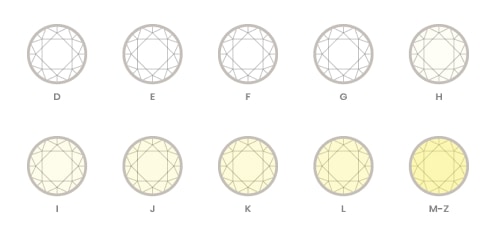Diamond Buying Guide
Understanding the 4 C’s of Diamonds
Many people are confused about how diamonds are priced. The best explanation is that asking for the price of a diamond is like asking for the price of a house. A real estate agent can’t quote you a price for a house without knowing its size, condition, location, etc. This process is the same one used when buying a diamond. A diamond’s beauty, rarity, and price depend on the interplay of all the 4Cs—cut, clarity, carat, and color.
The 4Cs are used throughout the world to classify the rarity of diamonds. Diamonds with the combination of the highest 4C ratings are rarer and, consequently, more expensive. No one C is more important than another in terms of beauty and it is important to note that each of the 4Cs will not diminish in value over time.
Once you have established those 4C characteristics that are most important to you, a jeweler can then begin to show you various options with quoted prices.

Clarity
Refers to the presence of inclusions in a diamond
Every diamond is unique. Nature ensures that each diamond is as individual as the person who wears it. Naturally-occurring features, know as inclusions, provide a special fingerprint within the stone. Inclusions are natural identifying characteristics such as minerals or fractures, appearing while diamonds are formed in the earth. They may look like tiny crystals, clouds or feathers.
To view inclusions, jewelers use a magnifying loupe. This tool allows jewelers to see a diamond at 10x its actual size so that inclusions are easier to see. The position of inclusions can affect the value of a diamond. There are very few flawless diamonds found in nature, thus these diamonds are much more valuable.
Inclusions are ranked on a scale of perfection, known as clarity, which was established by the Gemological Institute of America (GIA). The clarity scale, ranging from F (Flawless) to Included (I), is based on the visibility of inclusions at a magnification of 10x.
Some inclusions can be hidden by a mounting, thus having little effect on the beauty of a diamond. An inclusion in the middle or top of a diamond could impact the dispersion of light, sometimes making the diamond less brilliant.
The greater a diamond’s clarity, the more brilliant, valuable and rare it is—and the higher it is on the Diamond Quality Pyramid.

Cut
Refers to the angles and proportions of a diamond
Nature determines so much about a diamond, but it takes a master cutter to reveal the stone’s true brilliance, fire and ultimate beauty.
Based on scientific formulas, a well-cut diamond will internally reflect light from one mirror-like facet to another and disperse and reflect it through the top of the stone. This results in a display of brilliance and fire, thereby placing well-cut diamonds higher on the Diamond Quality Pyramid than deep or shallow-cut diamonds. Diamonds that are cut too deep or too shallow lose or leak light through the side or bottom, resulting in less brilliance and ultimately, value.

Color
Refers to the degree to which a diamond is colorless
Diamonds are found in almost every color of the rainbow, but white-colored diamonds remain most popular.
Diamonds are graded on a color scale established by the Gemological Institute of America (GIA) which ranges from D (colorless) to Z. Warmer colored diamonds (K–Z) are particularly desirable when set in yellow gold. Icy winter whites (D–J) look stunning set in white gold or platinum.
Color differences are very subtle and it is very difficult to see the difference between, say, an E and an F. Therefore, colors are graded under controlled lighting conditions and are compared to a master set for accuracy.
Truly colorless stones, graded D, treasured for their rarity, are highest on the Diamond Quality Pyramid. Color, however, ultimately comes down to personal taste. Ask a jeweler to show you a variety of color grades next to one another to help you determine your color preference.
Nature has also created diamonds in intense shades of blue, green, yellow, orange, pink or – rarest of all – red. These diamonds are called ‘colored fancies’ and are extremely rare and highly treasured.

Carat (Size)
Refers to the weight of a diamond
Carat is often confused with size even though it is actually a measure of weight. One carat is equivalent to 200 milligrams. One carat can also be divided into 100 “points.” A .75 carat diamond is the same as a 75-points or 3/4 carat diamond.
A 1-carat diamond costs exactly twice the price of a half-carat diamond, right? Wrong. Since larger diamonds are found less frequently in nature, which places them at the rarest level of the Diamond Quality Pyramid, a 1-carat diamond will cost more than twice a 1/2-carat diamond (assuming color, clarity and cut remain constant).
Cut and mounting can make a diamond appear larger (or smaller) than its actual weight. So shop around and talk to your jeweler to find the right diamond and setting to optimize the beauty of your stone.
How It Works
The easy three-step process for buying your diamond jewelry with us.
Schedule an appointment
With a few clicks, you can book a time to meet with the owner of Good Diamond Co. The online booking calendar is convenient for you to choose the best time for you along with easy text and email reminders.
Meet with us
Meet in person or online and have a conversation about your specific needs whether it is custom or readymade. We will listen and guide you to the perfect choice for your budget.
Enjoy your purchase
Browse through the selection of what’s available in our inventory and online with an optional expert’s assistance. You’ll receive your purchase in a safe and transparent transaction with trusted warranties.